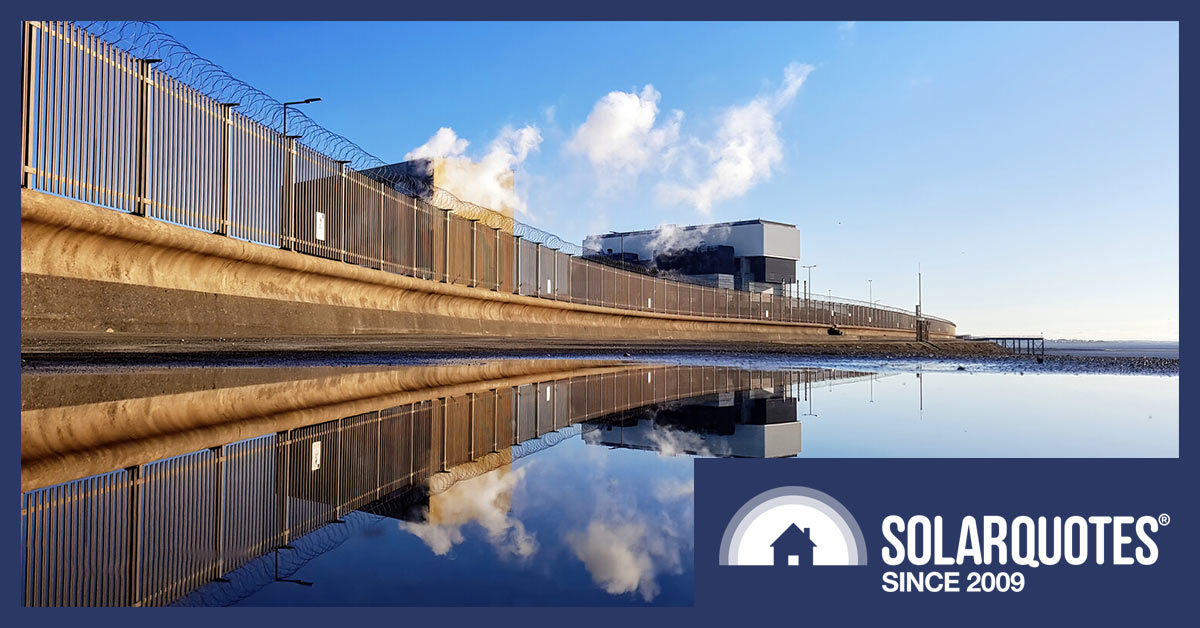
Last year the International Energy Agency (IEA) published a long report where — among other things — they predicted the rate of new nuclear construction would roughly double. When I first read this, I considered it nearly impossible. But now Russia has invaded Ukraine, I consider it flat out impossible. I expect new nuclear power will provide much less low emissions energy in coming decades than the IEA predicts.
A Long IEA Report
At the end of February, I wrote a looong blog post about a looong IEA report called…
In this post I’ll cover what the IEA report says about nuclear power and why their predictions were too optimistic even before the invasion of Ukraine.
The IEA report predicts new wind and solar power capacity will produce at least six times as much energy as new nuclear by 2040. This makes it seem like they don’t expect much growth in nuclear power generation, but even for their least optimistic prediction to come true, two things are required:
- A large decrease in the growth rate of solar and wind generation.
- A doubling of the growth rate for new nuclear power.
I don’t consider either of these prospects to be realistic. Now Putin has invaded Ukraine, I consider their predictions to have gone from unrealistic to unbelievable.
Massive Increase In Solar & Wind Compared To Nuclear
The IEA report considers two different scenarios:
- STEPS: In this is their STatEd Policies Scenario1, which assumes nations only meet commitments made in the Paris Climate Accord.
- SDS: This is the Sustainable Development Scenario where nations go beyond current commitments because of falling costs and/or increasing desire to slow climate change.
This graph shows how much generating capacity the IEA report predicts will be built for nuclear, wind, and solar power from 2020 to 2040 in each scenario:
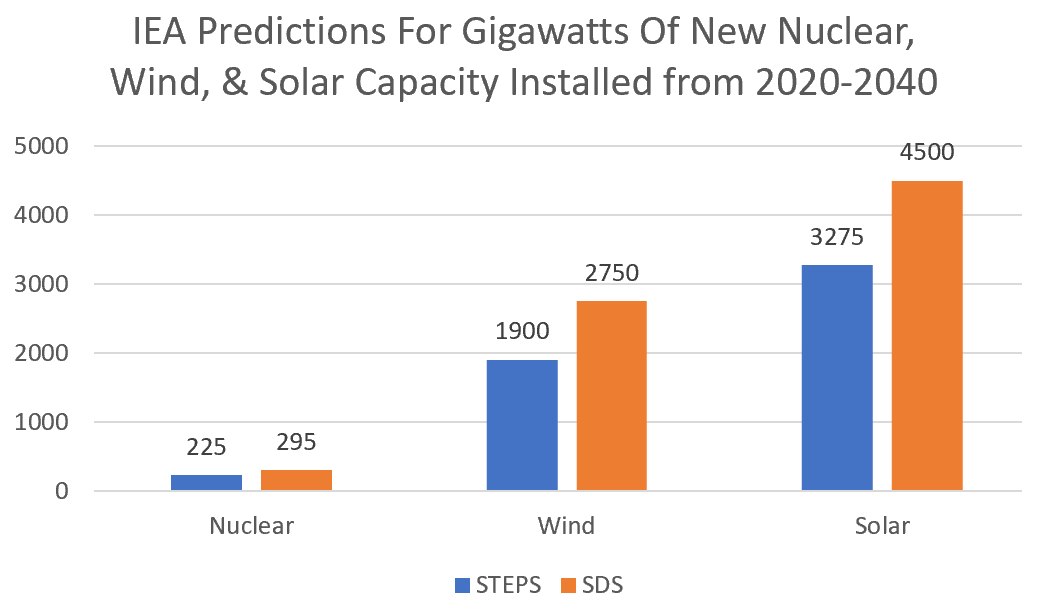
This makes it look like the IEA thinks new nuclear won’t play a significant role in the future compared to renewables. But comparing total capacity can be misleading. One gigawatt of nuclear power capacity provides much more energy than one gigawatt of solar or wind capacity. Capacity factor must be taken into account, otherwise, it’s like comparing high capacity factor apples to low capacity factor apples.
Capacity factor is how much energy is generated in the real world compared to how much would be generated if it continuously operated at its full rated capacity. I can’t be certain what the average capacity factor for new generation will be, but these estimates should be close:
- Nuclear 90%
- Wind 38%
- Solar 18%
Using these capacity factors I can estimate how much energy the IEA believes will be produced in 2040 by new generating capacity built from 2020:
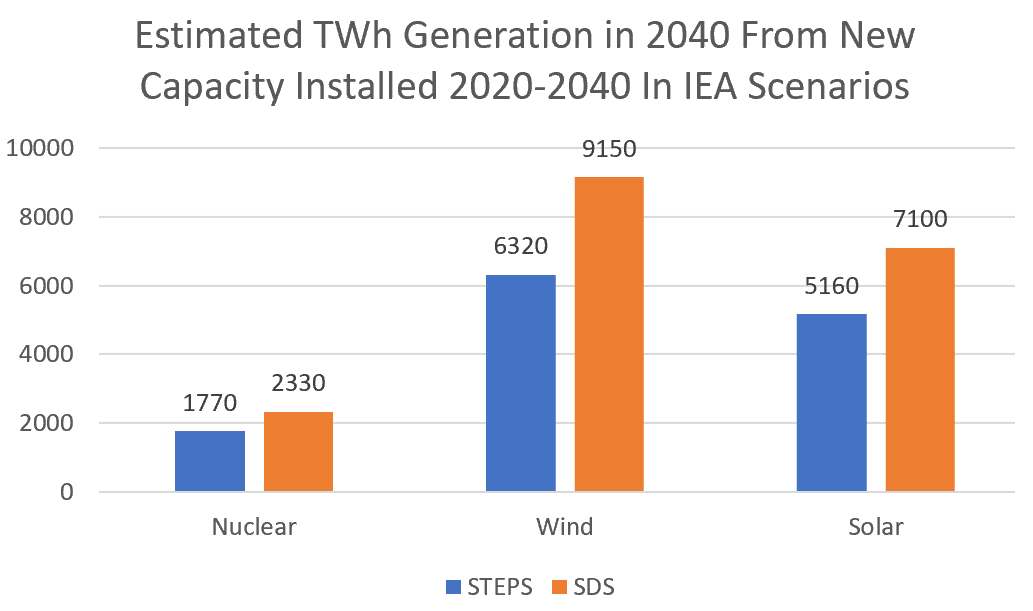
If you are wondering what TWh is – it stands for terawatt hour, which is one billion kilowatt-hours. One TWh is about how much electrical energy Bendigo uses in a year.
This makes new nuclear’s contribution appear a lot better. Compared to the total of wind and solar generation…
- STEPS: New nuclear is 15% of new wind and solar generation.
- SDS: New nuclear is 14% of new wind and solar generation.
With only 1 percentage point difference, the output of new nuclear is almost the same in relation to the output of new wind and solar energy generation in either scenario.
In reality, I expect the percentage of energy produced by new nuclear power will be much less because:
- I expect wind and solar generation to be higher than in either of the IEA’s scenarios.
- The IEA’s estimate for new nuclear construction is unrealistically high even for the less optimistic STEPS prediction.
- Putin’s invasion of Ukraine has caused the IEA’s rosy forecasts for new nuclear energy for this decade to go from unrealistic to impossible.
IEA Predicts A Large Decline In Growth Of Solar & Wind Growth
While the IEA report predicts a huge increase in renewable generating capacity by 2040, even their more optimistic scenario requires a large slowdown in the rate of growth of solar and wind. While a reduction is inevitable2 at some point…
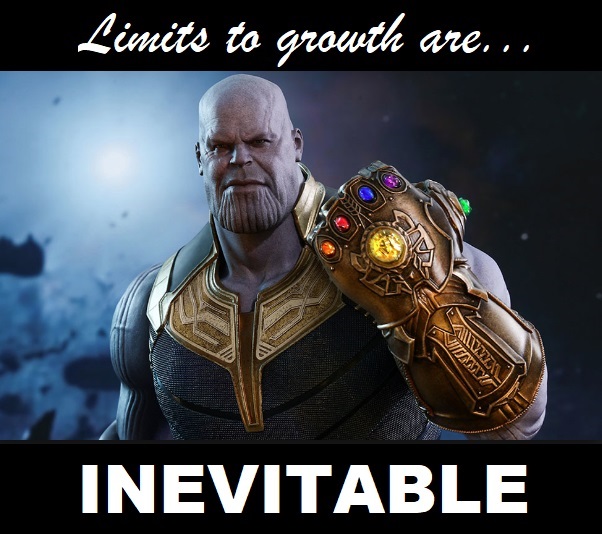
…the IEA has made this same prediction and got it wrong around 14 times in the past. I consider the odds of them being right this time to be slim.
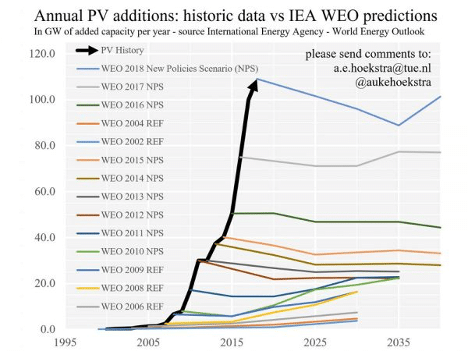
According to this, the IEA has predicted a decline in the growth of renewables about 14 times in the past was wrong each time. (Source: Apparently a Dutch person. So must be legit.)
Because solar and wind generation — along with battery storage — has been falling in cost while other forms of generation have not, I don’t think we’ll see anything like the growth slowdown the IEA predicts. On the graph below I’ve compared wind and solar capacity built in 2021 with the IEA’s prediction for how much will be built in their optimistic SDS forecast in 2030, along with how much will be installed if solar and wind capacity continue to expand a the same rate they have over the previous 10 years:
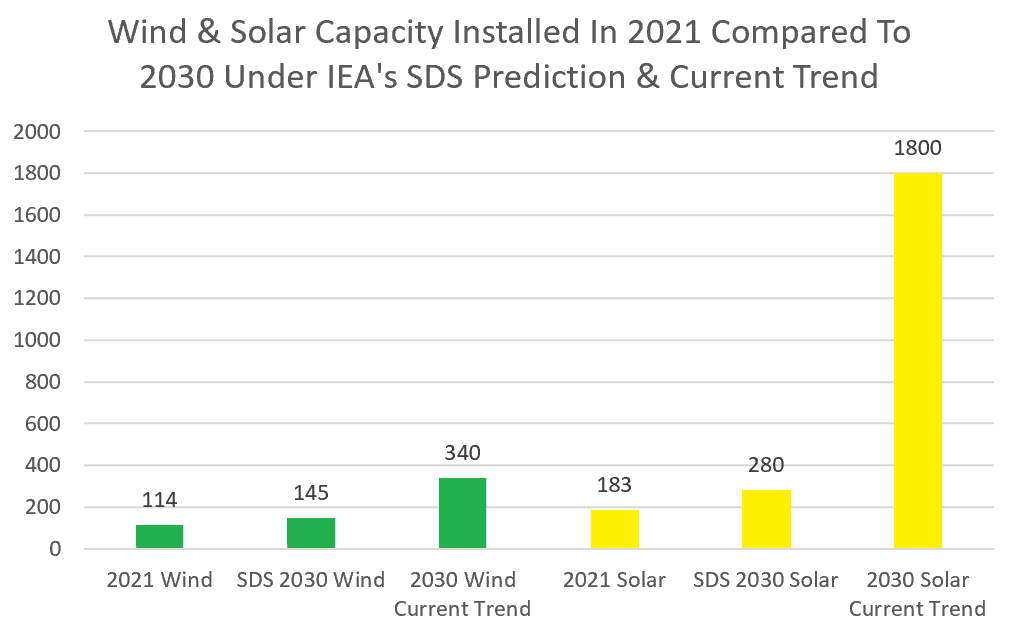
In the SDS prediction for 2030, compared to what was installed in 2021…
- Wind: Only 27% more will be installed in 2030 than 2021.
- Solar: Only 53% more will be installed in 2030 than 2021.
If current trends continue, then compared to the SDS prediction for 2030…
- Wind: 230% more wind capacity will be built.
- Solar: 640% more solar capacity will be built.
I’m not saying current trends will continue, but I am saying there is a lot of room for installations to be far higher than in the IEA’s more optimistic forecast.
Nuclear Power
The report predicts large decreases in solar and wind capacity growth rates, so you may expect a similar prediction for nuclear power. Instead, despite the falling cost of renewable energy, a large increase in nuclear’s growth rate is forecast. Something that’s now impossible — unless Emperor Putin makes reactor construction a condition of our continued existence.
For the past 10 years, the nuclear construction rate has been low. The graph below shows new nuclear power capacity built over this time, along with retirements:
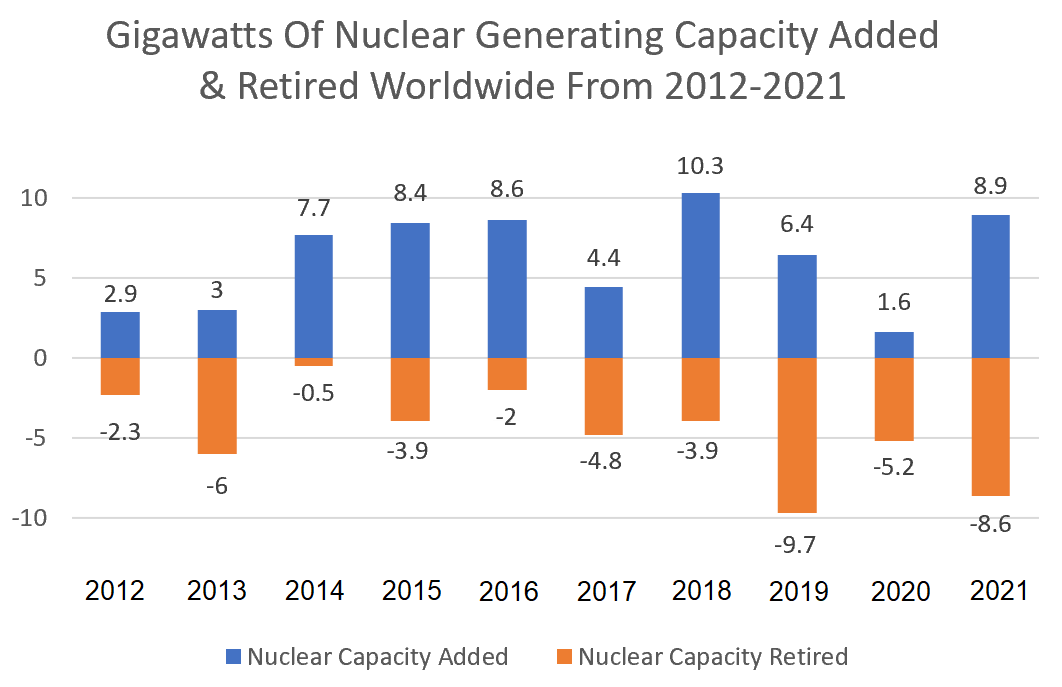
New nuclear construction has had a hard time keeping ahead of old reactors closing down, with retired capacity equal to around two-thirds of new capacity over the past 10 years. On average the net increase in nuclear capacity has been around 1.5 gigawatts per year.
The largest addition to nuclear capacity over the past 10 years was 10.3 gigawatts in 2018, while the lowest was in 2020 with 1.63 gigawatts. But in the IEA report, their graph puts nuclear power capacity added in 2020 at close to 10 gigawatts — six times the actual amount:
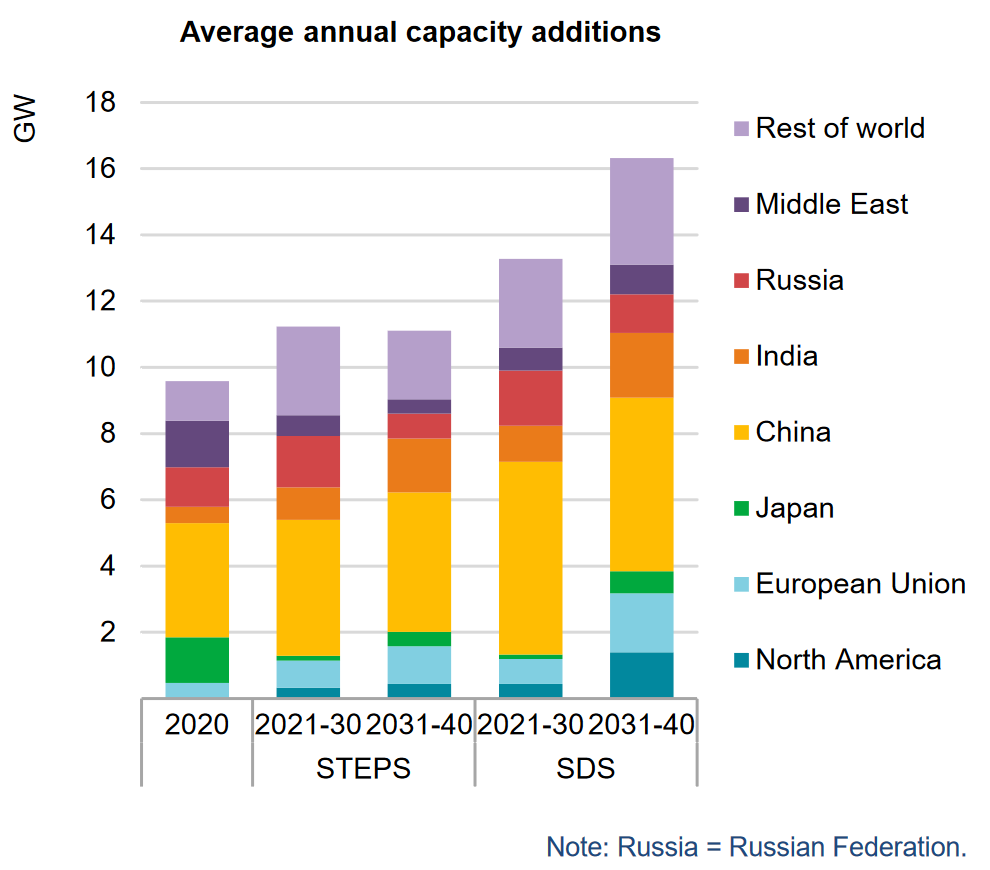
I checked the World Nuclear Association’s figures, and they say the world connected 3.176 gigawatts of new nuclear capacity to the grid in 2020. This is not the same as new reactors being commissioned and entering normal operation, but it’s still under one-third the IEA’s figure. I don’t know how the IAE got it so wrong, but this mistake really stands out as 2020 was the year with the lowest new nuclear power capacity addition for a very long time.
The IEA report says from 2021-2030 the world will see an average of over 11 gigawatts of new nuclear capacity commissioned each year in their STEPS prediction, and more than 13 gigawatts in their more optimistic SDS forecast. Over the past 10 years the world only averaged 6.2 gigawatts of new nuclear capacity commissioned each year, so even meeting the lower estimate of around 11 gigawatts is not realistic because, in the less than nine years that are left, the world would have to almost double the average rate of construction.
This would be easy for solar, wind, or battery capacity to achieve but — unlike these technologies — nuclear power is not a high growth industry. Even if there was a sudden increase in demand for nuclear energy generation it would take years for construction to ramp up.
Currently, there are only around 55 nuclear reactors, totalling approximately 45 gigawatts3, under construction. Over the past 40 years, the average construction time has been around 7 years. Assuming none of these projects are cancelled, which is unlikely, this suggests only around 6.5 gigawatts of new capacity will enter service each year.
Even if large new projects are announced, this is unlikely to change. For example, Macron recently announced France would build new reactors but, even if all goes well, the first isn’t likely to come online before 2035. Note things often don’t go well for nuclear power in France. Their Flamanville 3 reactor, which was supposed to be completed in 2012, has just had its commissioning delayed for at least two years.
Nuclear Power Is Not Competitive
An increase in nuclear construction is unlikely due to the high cost of nuclear power. I don’t expect small modular reactors to change this because, if cost overruns are ignored, the energy they provide is projected to be more expensive than larger reactors. While they may reduce cost overruns, current designs don’t have the potential to compete with renewable energy. If they did, India — which has 17 operational reactors of 205 megawatts or less — probably wouldn’t have stopped building them to concentrate on larger designs of 630 megawatts and up.
Nuclear power is unlikely to ever compete with renewable energy no matter what reactor technology is used. This is because, like coal power, it requires expensive heat exchangers4 while solar and wind generation have no need for them.
Nuclear’s Material Needs Are Low
One thing the IEA report mentions is nuclear power’s need for materials such as copper and nickel are less per kilowatt-hour generated than most forms of generation. This is mainly because modern nuclear reactors are designed to operate at a 90% or higher capacity factor. In comparison, new Australian wind power has a capacity factor of around 40%, while fixed solar is around 24% in Longreach and 14% on a north-facing roof in Hobart.
Nuclear’s high utilization rate makes its need for copper similar to run-of-the-river hydroelectricity5 per kilowatt-hour generated. On the downside, we can’t recycle some material used by nuclear power stations for a very long time. This is because it becomes radioactively contaminated and must be disposed of thoughtfully6.
Despite requiring much less material per kilowatt-hour generated than wind or solar generation, nuclear power is still far more expensive. Its lower material requirements are not enough to make it worthwhile economically or environmentally. This is because fossil fuel generation can be shut down faster and at less cost than by building renewable generation rather than nuclear.
Nuclear’s Future Harmed By Russian Invasion
Russia’s invasion of Ukraine has reduced the amount of new nuclear capacity we can expect to be built for two main reasons:
- Sanctions will cause reactor construction in Russia to halt and potentially be cancelled altogether.
- International nuclear power plant projects involving Russia are likely to be delayed or cancelled.
There is also a third reason which is less important, but may become number one if things go badly wrong:
- Fighting around the Chernobyl and Zaporizhzhia nuclear plants have made people think more about nuclear power’s liabilities.7
Russian Reactor Construction Will Halt
Currently, there are only two conventional nuclear reactors under construction in Russia, along with a 280 megawatt molten lead cooled prototype. Because Russian industry is heavily dependent on foreign machine tools and expertise, sanctions will cause work on these projects to come to a halt, whether they want it to or not.
Because they provide Putin with no immediate benefit, Russia’s limited foreign exchange reserves won’t be used to keep reactor construction going. While construction could start up in the future, it’s possible this will never happen. So far, Russia has started work on and then abandoned 19 nuclear power reactors8. If more end up added to the total I won’t be terribly surprised.
International Projects May Halt
While the halt and potential abandonment of work on Russian reactors are bad for nuclear energy’s prospects, the effects on international projects involving Russia may be greater.
Rosatom, Russia’s State Atomic Energy Corporation, is involved with nuclear power plants either under construction or planned in:
- Bangladesh
- Belarus
- China
- Egypt
- Finland
- Hungary
- India
- Turkey
While Rosatom isn’t directly targeted by sanctions at this time, projects may still be cancelled or delayed. For example, Finland has cancelled work on the Hanhikivi Nuclear Power Station that was to be built by Rosatom.
Another potential problem is Russia is a major supplier of nuclear fuel and current sanctions will make it difficult to maintain production. Reduced supply could raise its price, making nuclear energy even less economical than it already is.
If the international situation suddenly takes a turn for the far better, sanctions on Russia may be rapidly removed. But, even in this rosy scenario, the Russian economy will still be heavily damaged by the events of the past month for a long time to come and nuclear energy projects are still likely to be delayed or cancelled.
What’s Up With The IEA?
Between consistently under-predicting the expansion of renewable energy and forecasting an expansion of nuclear energy that was implausible even before the invasion of Ukraine, I’m kind of getting the impression the IEA considers its job to be letting politicians and business people know the world is changing while reassuring them it’s not changing too much.
This may not be done consciously, but you’d think they would have started to learn from their mistakes by now. Overestimating the amount of new nuclear capacity coming online in 2020 by a factor of six was a particularly puzzling error because IEA reports are normally free of typos and mathematical errors. It’s only their conclusions that tend to be stuck in the mud.
But that’s all I have to say. You now know everything about the IEA’s predictions for nuclear power from A to Z. This is the end of the article because, as everyone knows, Z always comes last.
Unfortunately, it has taken me 2,543 words to get here, which is well over the limit I set myself. I was going to tell you my favourite Ukrainian joke but, because it’s way too long, I’ll just mention a short Russian joke:
Putin.
Footnotes
- You can tell some really wanted the acronym to come out as STEPS. Someone in the IEA must have a huge weakness for Euro cover bands. ↩
- Limits to physical growth are unavoidable because the universe is expanding and entropy increasing. But there are no actual limits to economic growth as this is based on human desire. Depending on how literally you take certain economic theories, we can have unlimited economic growth by selectively breeding people to be greedier. ↩
- The World Nuclear Association says there are 58 gigawatts of nuclear capacity under construction, but their definition of under construction includes “thinking really hard about it”. The International Atomic Energy Agency says 53.6 gigawatts. I say, “If you ain’t pouring concrete, you ain’t serious”. ↩
- Yes, there are nuclear reactors that don’t require heat exchangers, but they won’t ever be cheaper than ones that have them. ↩
- This type of hydroelectricity doesn’t need a dam thing to store water. ↩
- This problem isn’t unique to nuclear power. Some pipes in natural gas refineries can become radioactive because of naturally occurring radon gas. But the problem is way worse for nuclear. ↩
- Speaking of liabilities, did you know the Chernobyl nuclear disaster caused radioactive silt to be deposited in the Kyiv Reservoir? If the dam wall is destroyed, in addition to the normal devastation that would result, it could result in a major radiological hazard. Fortunately, the dam is very strong and so very unlikely to be destroyed — by accident. ↩
- Going belly up before construction is complete is one of the major financial risks of nuclear power but, for some reason, it’s rarely mentioned. ↩

 RSS - Posts
RSS - Posts



If Electric Vehicles are the future, with 20,000,000 vehicles in Australia today.
1,000,000 new vehicles sold per year.
Each vehicle with a 100kwh battery for the 500 mile trip.
Each vehicle travelling only 50 miles a day. -10kwh, topped up daily
Each home with an over night need daily. -10kwh, from EV, topped up daily
Each home has daily need . -13kwh
Each home with a 6.6kw rooftop PV supply +33kwh daily
All EV plugged into the grid 24/7, except for rush hour.
All EV can trade spare power, 80kwh, with the grid and make money daily.
1,000,000 rooftop 6.6kw PV installations each year does not need NUCLEAR TRAINED workers.
200 work days, one day install = 5,000 install per day for 9 years.
8.3 million homes in Australia.
Or we install 80 BWRX300 nuclear power stations over 160 years.
Nuclear can not be the only answer for Australia because the world would need 100,000 nuclear power station to power the worlds electric vehicles and homes. If CO2 reduction is critical.
All dictatorships would be laughing with happiness, 200 countries with their own nuclear industries.
Actually, I see the automatic car plug in gadget as the next ‘killer invention’.
I said 8.3 million homes and 20,000,000 vehicles, so the home install would need an additional 15kwh because of the 2 to 3 vehicles per home.
Say 6.6kw + 3.3 kw = 9.9 kw, x 5 hours = 50kwh per day.
Yes I know people will blow up and say we can not run the world on batteries, an utter waste of materials, but we will have EVs with energy storage built in for the 500 mile trip.
We do not need to waste the energy storage AND build a monopoly owned nuclear world, with huge military costs, monopoly profits, monopoly political donations, monopoly investment costs locked in for 60 years.
Renewables costs are falling and are below nuclear costs now, with out the huge additional USA military costs for world security.
Nuclear technology will be ancient technology in 60 years and will block all other energy technology developments.
Stephen, your maths is fundamentally wrong.
Using your figures, at 1,000,000 EVs sold each year it’d require 20 years to replace all vehicles, except some people change vehicles far more regularly, EVs currently aren’t affordable for most Australians, and EV manufacturers simply can’t supply those sorts of numbers so we’re talking decades minimum before EVs form a majority let alone replace all petrol and diesel vehicles.
You said a 9.9 kw system getting a mere 5 hours of sunshine translates to 50kwh per day except that’s wrong too. While it depends where you are you’re looking at south of 35 kWh per day. That’s an average though not a minimum. What do you do when you have several low to no production days in a row? I have a larger than 9.9 kW system yet last month I had a 1.5 kWh day followed by an 11 kWh day and didn’t see a 50+ kWh day until the following month! Now that’s summer. What happens when you get successive grey winter days i.e. lowest yield months with reduced solar due to cloud?
As for nuclear technology being ancient, actually it’s still a cutting edge R&D field. Not in Australia perhaps but then Australian R&D is somewhat limited. Whether fusion power will ever get beyond research (or science fiction) is impossible to say.
You say nuclear proliferation is not necessary, but doesn’t that depend on the lessons one learns? Others looking at the Ukraine situation see nuclear proliferation as essential. Ukraine gave up their nuclear weaponry for a guarantee of security, and now Russia has invaded them, seized control of their nuclear powerplants, and we’re at risk of multiple meltdowns\dirty bombs\other environmental cataclysms. Note this isn’t an issue limited to nuclear power – destroying hydro dams would also be devastating.
You say Australia is ~8,000 million km2 of sunshine (actually 7,692,024 km^2) except landsize =/= sunshine. Depending on the month and capital city you’re in, average daily sunshine hours range from 3-11. Brisbane is apparently the most consistent – averaging 8 hours per day August to January and 7 hours February to July, but again average =/= consistent. On a wet and cloudy day you will get low to no sunshine.
You mentioned houses becoming self sufficient will allow the grid to focus on industry. Isn’t this where nuclear power, indeed any sort of reliable consistent power, would be optimal? With industry tending to have fixed demands, power plant construction could be matched against current and future demand. This contrasts with solar, or wind, which is unreliable. There are days when you cannot produce enough power to cover your own demand even with a larger than 9.9 kW system, others where even though you produce enough the peaks and troughs mean something as simple as boiling a jug draws on the grid because you aren’t consistently generating power, and of course there’s the whole night thing where the sun don’t shine.
There’s arguments for solar as being part of the package for power generation, and SQ tends to be all in on them – especially household generation, but relying exclusively on wind and solar for nationwide generation? Now that would be a dangerous choice risking a complete return to horse and buggy technology.
Good response George, Thank you
Good response George, Thank you
I came at this future energy problem from the nuclear cost point.
Many point to the now flat lining low nuclear power costs and I said to myself if nuclear is the best CO2 reduction solution, then 200 countries in the world must have their own nuclear industries.
And, that means say 100,000 nuclear BWRX300 reactors. That means every dictatorship in the world.
That means USA supplied additional military costs, on top of the projected nuclear costs.
FUNDIMENTALY nuclear is expensive because of both of these costs, AND we all could die.
Nuclear also has a construction time penalty and, at $billion each cost and financing problem and a highly skilled workforce shortage problem.
I then thought about vehicles, and apparently EV with a million less moving parts and no CO2, and with a big electrical energy storage capacity of 500 miles, but averaging only 50 miles each day would be a huge resource. Say 100kwh battery and needing only 10kwh top up daily.
Therefore, with a 10kwh roof system, there is a natural fit. Buy a car and get a free battery.
No need for nuclear for up to 40% of the grid.
We also know that Singapore wants to take Solar energy from south of Darwin via 3,300klm cable.
Melbourne is 3,200 klm from Darwin, so distance is not a problem.
I also bet that some were in Australia the sun is always shining on the ground and transmission capacity is nearby.
Vehicle sales are on the internet, and EV sales will get to a price point that nobody will want to buy a 2nd hand ICE vehicle and so people will go for free fuelled EV plugged into the grid and home and trading power like the big batteries are doing today.
Yes 20,000,000 is a lot of vehicles, but if sales double then in FIVE years half of the ICE vehicles will be in the recycle system and petrol will be given away at rock bottom prices and the rush will be on to change.
Twiggy Forest is investing $billions on hydrogen and ammonia fuels for export, so there are big changes and horse and buggy thoughts are not needed.
If nuclear is the only answer then the dictators will be laughing
If renewables are the answer then let the dictators steal that technology and save the world, Hahaha.
Stephen Brickwood,
“…if sales double then in FIVE years half of the ICE vehicles will be in the recycle system and petrol will be given away at rock bottom prices and the rush will be on to change.”
BIG IF! Firstly, the mining and transport of raw materials needed to produce EVs is currently dependent on petroleum fuels, particularly diesel. A global diesel fuel shortage predates the Russian invasion. Increasing diesel fuel prices raise prices for nearly everything, including for EVs. Ongoing high EV prices will likely discourage faster uptake.
https://www.solarquotes.com.au/blog/russian-invasion-iea-nuclear/#comment-1404310
Secondly, petrol will not be “given away”. There are costs (both monetary and energetic) incurred extracting and producing petroleum fuels, that are only going to get progressively higher as extractions from the remaining oil reserves become more difficult.
Thirdly, peak oil never went away. Global crude oil + condensate production peaked in Nov 2018. See Fig 4 at: https://www.artberman.com/2022/03/21/the-misunderstanding-of-oil-underinvestment/
The world is running out of pre-peak oil producing countries. We are likely now on the global oil supply downslope – see Fig 5 at: https://economicsfromthetopdown.com/2020/11/16/peak-oil-never-went-away/
Some people get lost in the details
To keep it simple CO2 bad.
Electric good.
Petroleum bad and running out.
Nuclear proliferation bad, military budgets go ballistic and add to nuke energy costs, bad bad.
Dictatorships bad.
We do nothing, bad bad bad bad BAD.
Solar energy supply good good good,
Solar PV systems 3 to 5 year pay back.
Solar PV life 25 years to 80% efficiency, then you add 20% more PV for the next 25 years. That is 50 years, or more, supply (with 3 extra panels at the 25 year point). Good good good
Stephen Brickwood,
“Some people get lost in the details”
Details usually matter. For example, Australia currently has only 3 weeks (or 21 days) in-country stock supplies at normal consumption of diesel fuels. The relatively little diesel fuel produced from the two remaining Australian refineries (Lytton, Qld & Geelong, Vic) are sourced mainly from imported crude oil. See Matt’s blog post at: https://crudeoilpeak.info/australian-oil-stocks-consumption-cover
Restrict/disrupt diesel fuel supplies and soon nearly everything is disrupted. IMO, that’s a critical detail.
I’d suggest the Australian Government’s Fuel Security Package 2021 will likely achieve very little benefits in an inevitable declining global oil supply regime. IMO, money would be better spent rapidly reducing Australia’s petroleum dependency.
https://www.energy.gov.au/government-priorities/energy-security/australias-fuel-security-package
Nuclear work force is limited. EXTREMELY LIMITED.
100,000 nuclear powered stations needed in a few years. The time frame is critical and is decades away.
The massive money invested will be stupendous, we can not even turn off coal fired power station because of their cash flow to the owners.
Floating nuclear stations are better than the Nuclear Power Plant in Ōkuma, Fukushima, Japan, ocean polluted ??????
Everybody gets lost in their own technology, I am a retired Civil Construction Engineer, and have had to face complex time and budget costs.
Most Engineers have their job on the line and hide in their technology. Most Engineers work in government or large companies and ‘toe the line’.
I have grandchildren, nuclear proliferation is not necessary.
In Australia we can not migrate to the cooler latitudes of the Great Southern Ocean, we are the sunniest country on the planet, we have a huge power transmission network.
40% of the network is our home needs.
90% of our petroleum is imported.
Self supplied homes doubles the capacity of the power transmission network for industry.
NOBODY PUTS THESE FACTORS TOGETHER.
Australia has different challenges and opportunities than countries like Norway or Sweden or Canada or Russia.
Canada has three provinces that mostly have enough hydroelectricity to run everything, like Norway does. But it has seven others that need coal, gas, or nuclear to survive through winter.
Wind power and large hydro storage with ground source heat pumps can keep much of the north warm enough to survive winter. But wind power is intermittent, usually stopping altogether when it’s very cold.
Surviving summer is far easier, mostly things like not golfing in thunderstorms or startling grizzly bears, or driving fast and / or drunk. We watch the solar panels crank the power meter backwards, and eat foos from the garden for three months.
There actualy is a place that Australians could go that’s a bit cooler. But once they’ve seen 40 below zero up close and personal, a lot of them won’t stay.
Australia has 25Gw installed capacity of fossil fuelled power stations now.
40% = 10 Gw can be freed up from the grid if home day and night is self supplied.
90% of imported petroleum can be dramatically reduced if self supplied top up of EV cars every day.
It is not horse and cart technology and it will not be ICE technology, it will be EV and GRID technology and 9million home roofs with PV.
And office, and shopping centres and malls, and factories and warehouses roof tops. Exactly were it is needed every day.
Farmers will be able to farm under their PV industrial installations.
Hydrogen and ammonia fuels will be created from EXCESS free solar.
Australia is 8,000 million km2 of sunshine. 7.692 million km²
The grid will be the money maker.
Are these predictions based on the concept that we’ll magically have mass storage available? Or that night time power use will just be cut off?
A combination of wind, existing hydroelectric capacity, and non-magical battery storage — both stationary and in electric vehicles — will provide most electricity demand at night. This is cheaper than using coal or coal seam gas, so I’m pretty confident it will occur. It’s not as if we don’t have gigawatt-hours of non-magical battery storage already.
Michael Oberhardt,
“Are these predictions based on the concept that we’ll magically have mass storage available?”
No magic involved. There are already a few Battery Energy Storage Systems (BESSs) operating in Australia, and within a few years there will likely be many more, bigger capacity systems.
https://reneweconomy.com.au/big-battery-storage-map-of-australia/
Additionally, there are some operational pumped-hydro systems, and more proposed.
https://reneweconomy.com.au/pumped-hydro-energy-storage-map-of-australia/
“Or that night time power use will just be cut off?”
The expansion of renewables and new methods of energy management and storage can lead to a grid that is reliable and clean.
https://e360.yale.edu/features/three-myths-about-renewable-energy-and-the-grid-debunked
I’d suggest it’s wishful/magical thinking to expect nuclear fission generator technologies would be operable in an inexperienced country like Australia earlier than 15-20 years.
https://www.solarquotes.com.au/blog/campbell-newman-nuclear-mb2380/#comment-1394008
“The expansion of renewables and new methods of energy management and storage can lead to a grid that is reliable and clean.”
Can, or will? Those are vastly different things!!!
George Kaplan,
“Can, or will?”
“Can” means it’s possible.
“Will” requires motivation/determination, competency and effective action.
If you take a defeatist attitude then it certainly won’t happen.
I would interpret can in this context as having the possibility of but absolutely not being a certainty, perhaps not even being a probability, hence the question.
Will in this context is a guarantee that what you refer to absolutely will happen.
It’s not defeatism, it’s linguistics.
We dont need magical mass storage.
I know i will be energy self sufficient if i installed pretty much any home battery, and still be exporting excess to the grid.
We just need current storage reliable and affordable
One oft-ignored cost of nuclear power generation is the cost of decommissioning reactors. As an example, the UK reactors at Sellafield have not produced electricity since 2003. However, in 2022 decommissioning is still ongoing and the disposal of high-level radioactive waste continues: see
https://www.onr.org.uk/sellafield-dfw.htm
The disposal of high-level radioactive waste is a problem that we would rather ignore and leave it to those of the future to solve.
And secrecy regarding waste disposal, and public subsidies for private operators, make real costs difficult to assess but there is little doubt that nuclear power is no longer a cost-effective energy alternative.
Various articles can be found which indicate that Australia’s defense capability is severely restricted by it’s heavy dependence on fossil fuels, especially oil and diesel fuel.
According to this article on the ABC at:
https://www.abc.net.au/news/2022-03-21/calls-for-evs-to-wean-australia-off-foreign-oil-imports/100911930
“Australia imports 90 per cent of its oil needs from overseas suppliers, with much coming from China
Defence experts say the reliance leaves Australia’s economy critically exposed to supply disruption
Fears of conflict in the Asia-Pacific have led to calls for Australia to speed up its shift to EVs, green transport”
Overall, our national dependency on fossil fuels sourced from overseas is described as a ‘MASSIVE vulnerability’. so far as Australia’s military security and and our overall defence capabilities are concerned.
According to this article at:
https://australiainstitute.org.au/report/fossil-fuel-subsidies-in-australia/
“In 2020-21, Australian Federal and state governments provided a total of $10.3 billion worth of spending and tax breaks to assist fossil fuel industries.
The $7.8 billion cost of the fuel tax rebate alone is MORE than the budget of the Australian Army. Over the longer term, $8.3 billion is committed to subsidising gas extraction, coal-fired power, coal railways, ports, carbon capture and storage, and other measures.”
I’m not sure why the Australian Institute used only what appears to be just the ‘army’ portion of the total defence budget. Possibly that’s because their activities tend to be much more ‘land-based”. or alternatively its due to the somewhat confusing wording, government terminology, and varying number rounding practices used on different pages of budget documents.
Australia’s total defence budget for 2019-20 was $38.7 billion according to this web-page here: https://www.army-technology.com/news/australian-defence-budget-increases/
The budget estimate for the total defence portfollo for 2021-2022 was
$43.75 billion, according to the government document which can be downloaded from:
https://defence.gov.au/Budget/21-22/2021-22_Defence_PBS_00_Complete.pdf
But regardless of any confusion (including my own), my rough calculations suggest that $10.3 billion dollars of annual ongoing fossil fuel subsidy is enough to put solar PV on the roofs of an extrar 1.287,500 households every year. (I’m assuming $8000 average cost of a roof-top solar PV installation)
If the current fossil fuel subsidies continue for another 3 years or so, it would be equivalent to 1 full year of our country’s entire defence spend.
Starting from around 2016 or so our defence forces have been attempting to install solar where they can on warehouses, storage depots, accommodation and other support facilities. They’ve now asked for further capital budget supplements to increase their usage of EV’s of various types, along with further expansion of roof-top solar
Defence believe doing so will bring considerable annual savings which can then be spent on other quite pressing military needs.both now and in the longer term future.
Des Scahill,
“Australia imports 90 per cent of its oil needs from overseas suppliers, with much coming from China.”
China was a significant supplier of petroleum products to Australia, but apparently not recently. See Matt’s analysis up to Sep 2021 at: https://crudeoilpeak.info/australian-fuel-import-dependencies-sep-2021-data
More recent data is available from the Australian Petroleum Statistics website at: https://www.energy.gov.au/government-priorities/energy-data/australian-petroleum-statistics
In Oct 2021, the BBC reported that China was rationing diesel supplies domestically.
https://www.bbc.com/news/business-59059093
The dire global diesel supply situation predates the Russian invasion of Ukraine.
https://www.smh.com.au/business/markets/the-oil-price-surge-is-bad-the-diesel-crisis-is-worse-20220315-p5a4ne.html
Meanwhile, international market fuel prices are apparently on the rise again, particularly for diesel.
https://www.aip.com.au/pricing/international-prices/international-market-watch
So much hyperbole, so little reality in this article.
How much does a 1-2 MW portable nuclear power plant cost? We don’t know yet, but for the reasons in your article, it will be a far more efficient use of the materials required, per KWh consumed.
Sweeping bogey man gas production under the rug by outsourcing it to Russia is why Germany and Belgium were able to score brownie points for closing old school nuclear plants. Belgium has just announced a ten-year extension for two plants, and Germany has already begun reoping several.
Electric transportation including buses and intercity rail requires a massive increase in electricity generation – not mere replacement of aggregate generation. Batteries and pumped hydro have their place but are a buffer, not a source, and impose a 15-20% load on the charge they store for later use.
So much more could be said, but the bottom line is that nuclear power is a major part of meeting the world’s energy needs, and the cost per unit of available power is lower, not higher. They also require less resources to make, and only occupy a small footprint on the land.
Thank you for the thought provoking article. It does contain some facts, but they indicate conclusions closer to the official prediction.
If there is anything wrong in the article — as in factually incorrect — please let me know and I’ll correct it.
Francis Young,
IMO, you reveal so much baseless opinion, so little reality in your comments.
“…the cost per unit of available power is lower, not higher.”
Where’s your evidence/data, Francis?
The evidence/data is see shows nuclear fission technologies are far more expensive compared with much cheaper alternatives. See my thread of comments starting from: https://www.solarquotes.com.au/blog/campbell-newman-nuclear-mb2380/#comment-1394008
The last great hope of nuclear proponents is for Small Modular Reactors (SMRs), notably including NuScale’s proposal. This hope has been around for a long time, with an arrival always in the future.
https://reneweconomy.com.au/small-modular-reactor-rhetoric-hits-a-hurdle-62196/
Francis, you wrote, “How much does a 1-2 MW portable nuclear power plant cost?”
Was that a typo? Because I can tell you that’s going to cost a lot. It would require highly enriched U235 of either weapons grade or close to it. Even if you got a reactor that size for free you’d have to pay through the nose for people with guns to sit around and chew bubble gum and not kick arse until someone tried to take it or turn it into a radiological hazard.
Plutonium could be used instead of enriched U235, but that doesn’t solve the problem.
A piece of plutonium the size of an 70gm egg and weighing 1.4 kg can be used to make an atomic bomb. People steal gold all the time
Exactly
The ABC did a show about nuclear power in Australia.
The Host surrounded herself with experts, ANTCO, Nuclear PHd scientist, Nuclear Engineer, and others. They have a limited and invested view.
The one opponent, an older women who spoke strongly against, but was constrained by her background.
She spoke about the suffering of people from nuclear accidents, and the experts loved it, because they immediately ran out their statistics to belittle her point of view.
The Host was helpless.
If the world is to reduce CO2, then all facts have to be included.
90% of the world is dictatorships, Putin is threatening Nukes now on his neighbour, and naturally himself.
Every country will have its own nuclear industries.
The USA is the biggest target in the world and will upgrade its military budget massively.
The dollar additional costs on top of nuclear reactor costs will be mind blowing.
The external costs for stopping CO2 is the ONLY REASONS for stopping CO2.
The external costs for NUCLEAR POWER can not be ignored. But all we hear is silence except for a women struggling with very limited arguments and professional reputation.
Nuclear power solutions will block innovation in renewable and the wide spread take up.
Reply to Frances Young…
At a page updated as recently as December 2021
The World Nuclear Association describes its progress with SMRs as follows:
“SMR Start has called for the DOE’s LTS programme for SMRs to be extended to 2025 with an increase in funding. It pointed out: “Private companies and DOE have invested over $1 billion in the development of SMRs. However, more investment, through public-private partnerships is needed in order to assure that SMRs are a viable option in the mid-2020s. In addition to accomplishing the public benefit from SMR deployment, the federal government would receive a return on investment through taxes associated with investment, job creation and economic output over the lifetime of the SMR facilities that would otherwise not exist without the US government’s investment.”
Further on in the article we find that in March 2021, the USA Department of Defence (DOD) said:
“Project Pele is on track for full power testing of a mobile reactor in 2023, with outdoor mobile testing of a prototype microreactor built at Idaho National Laboratory or Oak Ridge National Laboratory in 2024″
Note the use of the word ‘prototype” and the fact that this single mobile reactor hasn’t as yet been tested at full power output.
Similarly, NuScale Power, which until March 2020 was considered to be the industry leader in SMR technology had initial approval for its construction designs temporarily halted when…
“….a panel of independent experts from the NRC’s Advisory Committee on Reactor Safeguards (ACRS) found several potential flaws in NuScale’s reactor design.[45] The main issue was that in the event of an emergency shutdown condensed steam returning to the reactor vessel would be low in boron and might not absorb enough neutrons from the reactor. NuScale modified its design to ensure that more boron would spread to the returning water. The ACRS was still concerned that operators could accidentally add deboronated water to the core. The panel found a few more problems, such as that the steam generator could be prone to damaging vibrations.
However, on 29 July the ACRS still recommended that the safety evaluation report be issued and that the reactor be certified.[45] Edwin Lyman, a physicist from the Union of Concerned Scientists, said that the flaws in the design have damaged NuScale’s credibility and that “This is a case of the public relations driving the science instead of the other way around”.[45] On the other hand, José Reyes, NuScale’s cofounder and CTO said, “If there really was a fatal flaw, ACRS would not have published a positive report.” You can find this info on:
https://en.wikipedia.org/wiki/NuScale_Power
According to a World Energy Forum article dated 13 Jan 2021 which can be viewed here:
https://www.weforum.org/agenda/2021/01/buoyant-global-outlook-for-small-modular-reactors-2021/
‘Despite the encouraging noises emerging from government agencies, it is still far from clear how SMRs will overcome many of the challenges that are causing mainstream nuclear to suffer in markets such as the U.S. and the U.K.
No new nuclear power plant is viable in the U.S. now,” said Edward Kee, CEO and principal consultant at the Nuclear Economics Consulting Group, in an email.
Existing merchant nuclear power plants are closing early because they cannot cover cash-generating costs with sales into the electricity markets. [It’s] hard to see how a new nuclear power plant of any design could recover investment in this market.”
As it stands today, the only countries in the world that can claim to have a viable SMR industry is Russia.”
Existing SMR technology is simply not viable at the present time, and likely to remain so for quite some years. The debate over ‘nuclear generation’ seems to have achieved very little at all, other than to further delay any meaningful transition to renewable sources.
That same delay has no doubt played a role in causing the fossil fuel industry to continue being subsidized/propped up by some $10.8 billion each and every year in currrent dollars. That’s public money that could have been far better spent on many other things in my view.
total of more than 17GW of installed small-scale PV capacity by the year’s end, 2021.
Australia’s installed capacity of fossil fuelled power stations today is 25GW
With EV cars roll out, with their huge batteries, and the additional PV installations Australia’s renewable power industry will demonstrate to the world what is possible.
And if we go even heavier with renewables we could produce Iron and Steel again with cheap power at the iron ore mine site itself.